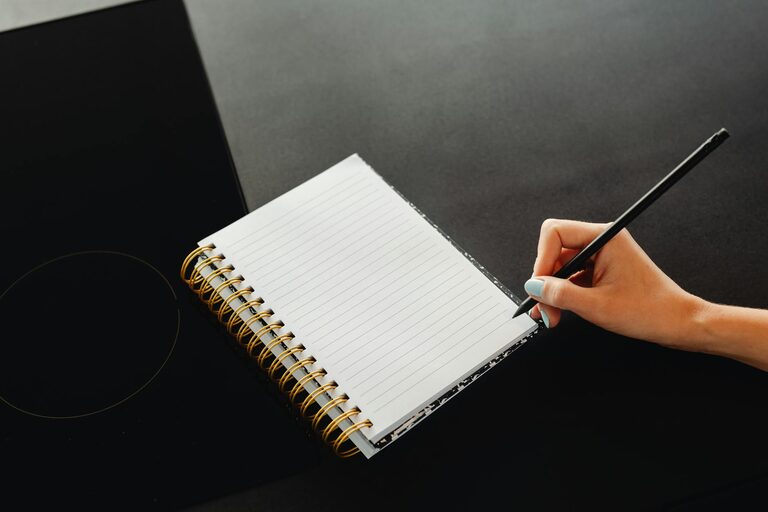Bullet journaling has grown into a popular way to combine planning, organization, and creativity into a single notebook. Whether you want to keep track of your daily tasks, set goals, or express yourself artistically, a bullet journal can be a fantastic tool. If you’re new to this method and wondering where to start, this guide will walk you through everything you need to know to begin your bullet journaling journey.
What is a Bullet Journal?
A bullet journal (or BuJo) is a customizable, analog system for organizing your life. Created by Ryder Carroll, it’s designed to be a flexible way to keep notes, plan your days, track habits, and much more — all in one notebook.
Instead of using multiple planners, apps, or sticky notes, bullet journaling helps you capture everything in a simple, structured format. It can be as minimalist or as artistic as you want, making it perfect for beginners and creative users alike.
Why Start Bullet Journaling?
– Stay organized: Keep track of appointments, tasks, and goals all in one place.
– Boost productivity: Prioritize your to-dos and manage deadlines effectively.
– Increase mindfulness: Reflect on your habits and progress.
– Express creativity: Customize layouts, doodle, and decorate your pages.
– Reduce stress: Having everything written down can help clear your mind.
Essential Supplies to Get Started
You don’t need fancy tools to begin bullet journaling. Here’s a simple list of essentials:
– Notebook: Many prefer dotted or grid notebooks, but lined or blank pages work too. Popular brands include Leuchtturm1917 and Moleskine.
– Pen: Choose a pen that feels comfortable. Gel pens, fineliners, or even pencils work well.
– Ruler: Useful for drawing straight lines and creating grids.
– Optional: Colored pens, markers, stickers, or stamps for decoration.
Basic Bullet Journal Symbols
Bullet journaling uses symbols called “bullets” to help categorize your entries:
– • (dot): Task
– ◦ (circle): Event
– – (dash): Note
– X: Completed task
– > (arrow): Task migrated (moved to a later date)
– < (arrow): Task scheduled (planned for the future)
These simple symbols assist in quickly scanning your journal and knowing what needs your attention.
Key Sections of a Bullet Journal
1. Index
The index is like a table of contents. Each time you create a new spread (two facing pages), record the page number and a brief description in the index. This makes it easy to find important pages later.
2. Future Log
This section helps you plan ahead for months or even the entire year. It includes big events, deadlines, or appointments scheduled in the future.
3. Monthly Log
The monthly log breaks down your month with important dates and tasks. There are two ways to set it up:
– A calendar-style grid with numbers for each day
– A list format with days and corresponding dates
4. Daily Log
This is where you write your day-to-day tasks, events, and notes. You can update it each morning or the night before. Most bullet journaling users write only the current day’s entries—this keeps it simple and focused.
5. Collections
Collections are specially dedicated pages for specific topics like books to read, habit trackers, fitness goals, travel plans, or meal ideas. They keep everything organized and easy to reference.
Step-By-Step Guide to Starting Your Bullet Journal
- **Set up the index:** Leave the first few pages blank to track your content.
- **Create a future log:** Divided into months, add any future appointments or goals.
- **Set up the monthly log:** Layout your current month with dates and space for tasks.
- **Create your daily logs:** Add today’s date and list your tasks, events, and notes.
- **Use bullet symbols:** Mark entries as tasks, events, or notes.
- **Review and migrate:** At the end of each day or month, review unfinished tasks. Migrate important tasks forward or schedule them.
- **Add collections:** Start with simple lists or trackers related to your interests.
Tips for Bullet Journaling Success
– Start simple: Avoid getting overwhelmed with elaborate designs; functionality matters most.
– Be consistent: Try to update your journal daily or weekly for best results.
– Customize to fit your needs: Change layouts or add sections that improve your workflow.
– Use color sparingly: Colors can organize and highlight, but use what feels right for you.
– Don’t stress over mistakes: Use white-out or create “correction pages” for errors.
– Incorporate habit trackers: Monitoring daily habits can boost motivation and accountability.
– Keep it portable: Use a notebook size that’s easy to carry around.
Example Layout Ideas for Beginners
– Basic Monthly Log:
| Date | Day | Task/Event |
|——-|—–|——————————|
| 1 | Mon | Dentist appointment at 3 PM |
| 3 | Wed | Grocery shopping |
| 7 | Sun | Family dinner |
– Simple Habit Tracker:
| Habit | M | T | W | T | F | S | S |
|————|—|—|—|—|—|—|—|
| Drink Water| ✓ | | ✓ | ✓ | | ✓ | |
| Exercise | | | ✓ | | ✓ | | |
Conclusion
Bullet journaling is an adaptable, enjoyable way to bring more organization into your life. As a beginner, focus on learning the system and adapting it to your unique style. Remember, there’s no “right” way to bullet journal — it’s your personal tool, so make it work for you!
Ready to start? Grab a notebook, and begin your bullet journaling journey today. Over time, you’ll see how this simple habit can help you stay productive and inspired.
—
Happy journaling!

